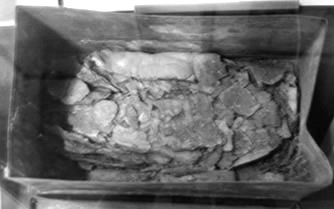The History of Time Capsules
Time capsules have been used for thousands of years to preserve a piece of the present for the future. Though time capsules are commonly thought of as a box of buried treasure, there are actually four distinct types. They can either be intentional or unintentional (such as Pompeii) and those which are meant to be opened on a certain date and those that are not. The time capsules discussed in this site will all be intentional time capsules. A large celebration such as a World Fair or the raising of a new building often encourages people to lay a time capsule. This website will discuss the relationship between the cornerstone celebration and the time capsule.
The copper box that was recovered from the foundation of the Synagogue in Victoria during renovations of the building. The time capsule and its contents are now an important display feature at the Synagogue.
The word “time capsule” was first used in 1937 when a capsule was prepared for burial for the 1939 New York World’s Fair. However, the notion of the time capsule is much older. The Epic of Gilamesh is considered humanity’s earliest literary work. The book opens with instructions of how to find a box of copper located in the foundation stone of the great walls of Uruk. In the box were the tales of Gilamesh. Therefore, the idea of leaving a message for the future in the form of a time capsule is more than 5,000 years old.Today we are very familiar with the idea of leaving a piece of ourselves for a future civilization. Time capsules are used as a way of communicating with a distant people. In fact, there are currently two time capsules in space. Voyager Golden Record I and II were attached to two Voyager spacecrafts and launched in 1977. This time capsule (I and II are identical) is a gramophone record meant to portray culture on earth to any intelligent extraterrestrial life. Music, natural sounds, images from around the world and greetings in 55 languages are included on the record. This is an example of a time capsule with an unknown opening date.
Intentional time capsules have been criticized by historians as they do not provide much useful historical data. Useless items include outdated technology or unused, pristine items. More useful items are photos and documents that describe everyday life. A second critique of intentional time capsules concerns preservation problems. Papers often disintegrate, groundwater destroys capsules that are buried, and the precise location of the time capsule can be lost over the passage of time. While the critique suggests that time capsules may not provide an accurate representation of the society, they can give us valuable information. The societal ideas of time and the importance of certain objects are represented in the contents of the time capsules we find today.
In the Victorian era there was a societal shift in which more emphasis was placed on the importance of time commemoration. The creation of a time capsule is an example of how people of the Victorian era commemorated time. Time capsules can be found in many cornerstones of buildings built in the Victorian era in Victoria, British Columbia. The content of each time capsule varies; however, the “usual deposits” include coins, newspapers, and religious or historical statements. These objects show us the importance of religion and prosperity during the era. They also give us a glimpse into the Victorian understanding of time. These time capsules had no intended retrieval date and were expected to endure until the apocalypse.
Click to view Time Capsule References.
Click to view the contents of all Time Capsules listed on this site.






